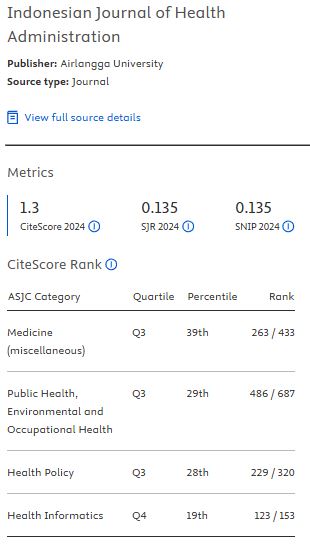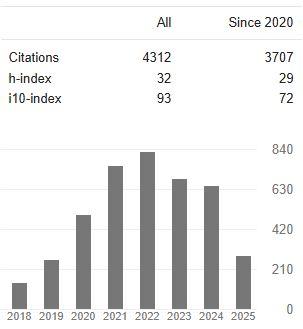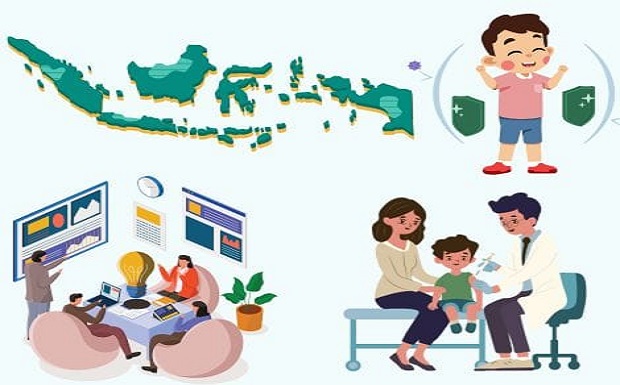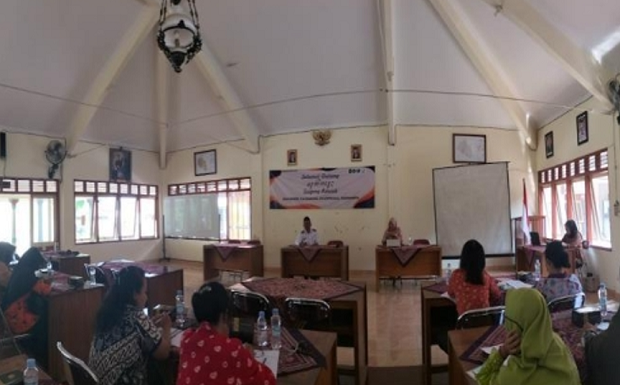Evaluasi Sistem Pelaporan Insiden Keselamatan Pasien di Rumah Sakit
Downloads
Background: Incident reporting systems are designed to obtain information about patient safety and used for organizational and individual learning.
Aims: The objective is to evaluate the implementation of patient safety incident reporting system at a hospital of Surabaya.
Method: This study was an observational descriptive research supported by qualitative data. This study used Health Metrics Network (HMN) model.
Results: The results of the input evaluation show that there was a policy that regulates the incident report, but its implementation was still not appropriate with no direct funding. However, facilities were provided for reporting. There were socialization for employees who have different understanding and responsibility, organizational structure of the patient safety team, problem solving method which had not used PDSA (Plan, Do, Study, Action), and computerized technology.
Conclusion: The process evaluation shows that the indicators were in line with the rules. The data sources were in accordance with the guidelines. Data collection, process, presentation, and analysis were in line with the theory. The output evaluation shows the submission of incident reports had not been timely. Moreover, the report was complete and suitable to the existing guidelines, and it had been used for decision-making. It is required for the hospital to revise the guidebook of incidence reporting and improve the human resource skill.
Keywords: evaluation, incident, patient safety, reporting
Arfan, A. N., Pasinringi, S. A. . and Sidin, A. . I. (2013) Gambaran Determinan Insiden Keselamatan Pasien pada Petugas Kesehatan di Rumah Sakit Universitas Hasanuddin. Universitas Hasanuddin, Makasar. Available at: repository.unhas.ac.id.
Çeken, C. (2014) ‘A Framework Study for Healthcare Information Systems', Journal of Computer and Communications, 2(September), pp. 61–67. doi: http://dx.doi.org/10.4236/jcc.2014.211008 A.
Doherty, C., Stavrapoulou, C. and Tosey, P. (2015) ‘How TEMPEffective Are Incident-Reporting Systems for Improving Patient Safety? A Systematic Literature Review', Teh Milbank Quarterly, 93(4), pp. 826–866. doi: 10.1111/1468-0009.12166.
Elliott, P., Martin, D. and Neville, D. (2014) ‘Electronic clinical safety reporting system: A benefits evaluation', Journal of Medical Internet Research, 2(1), pp. 1–10. doi: 10.2196/medinform.3316.
Gunawan, Widodo, F. Y. and Harijanto, T. (2015) ‘Analisis Rendahnya Laporan Insiden Keselamatan Pasien di Rumah Sakit', Jurnal Kedokteran Brawijaya, 28(2), pp. 206–213. Available at: jkb.ub.ac.id/index.php/jkb/article/download/962/479.
Hakim, L. and Pudjirahardjo, W. J. (2014) ‘Optimalisasi Proses Koordinasi Program Keselamatan Pasien (Patient Safety) Di Rumah Sakit X Surabaya Optimization of Coordinating Process of Patient Safety Program in Hospital X Surabaya', Jurnal Administrasi Kesehatan Indonesia, 2(3), pp. 198–208. Available at: journal.unair.ac.id/download-fullpapers-jaki3404f1d0abfull.pdf.
Handayani, T. et al. (2013) ‘Evaluasi pelaksanaan sistem pelaporan rekam medis di klinik asri medical center', Jurnal Manajemen Informasi Kesehatan Indonesia, 1(2), pp. 26–32. Available at: https://jmiki.aptirmik.or.id/index.php/jmiki/article/viewFile/47/33.
Indonesia, M. K. R. (2017) Peraturan menteri kesehatan Republik Indonesia Nomor 11 Tahun 2017 tentang Keselamatan Pasien, Peraturan Menteri Kesehatan Republik Indonesia Nomor 11 Tahun 2017 Tentang Keselamatan Pasien Dengan. Indonesia. Available at: jdih.baliprov.go.id/produk-hukum/download/12274.
Jakti, U. B. (2016) Evaluasi Sistem Informasi Jejaring Rujukan Maternal-Neonatal (SIJARIEMAS) di Kabupaten Tegal dengan Pendekatan Model Health Metrics Network (HMN). Universitas Diponegoro. Available at: http://eprints.undip.ac.id/49454/.
Komite Keselamatan Pasien Rumah Sakit (2015) Pedoman Pelaporan Insiden Keselamatan Pasien (IKP), Komite Keselamatan Pasien Rumah Sakit. Jakarta. Available at: www.pdpersi.co.id.
Kurniavip, A. L. L. and Damayanti, N. A. (2017) ‘Hubungan Karakteristik Individu Perawat dengan Insiden Keselamatan Pasien Tipe Administrasi Klinik di Rumah Sakit Umum Haji Surabaya', Jurnal Administrasi Kesehatan Indonesia, 5(2), pp. 117–122. doi: 10.20473/jaki.v5i2.2017.117-122.
Mbondji, P. E. et al. (2014) ‘Health information systems in Africa: descriptive analysis of data sources, information products and health statistics', Journal of Teh Royal Society of Magazine, 107(15), pp. 34–45. doi: DOI: 10.1177/0141076814531750.
Network, H. M. (2012) Framework and standards for country health information systems - second edition, World Health Organization. Switzerland. doi: 10.4018/978-1-60566-988-5.
Nurmansyah, M. I. et al. (2015) ‘Assessment of Nutrition Information System Using Health Metrics Network Framework', Jurnal Kesehatan Masyarakat Nasional Vol., 10(1), pp. 1–9. Available at: https://www.neliti.com/id/publications/147013/assessment-of-nutrition-information-system-using-health-metrics-network-framewor.
Pham, J. C., Girard, T. and Pronovost, P. J. (2013) ‘What to do wif healthcare Incident Reporting Systems', Journal of Public Health Research, 2(27), pp. 154–159. doi: 10.4081/jphr.2013.e27.
Sanjaya, P. D., Rosa, E. M. and Ulfa, M. (2017) ‘Evaluasi Penerapan Pencegahan Pasien Berisiko Jatuh di Rumah Sakit', Jurnal Fakultas Kesehatan Masyarakat, 11(2), pp. 105–113. Available at: http://journal.uad.ac.id/index.php/KesMas/article/download/6013/pdf_98.
Taylor, M. J. et al. (2014) ‘Systematic review of teh application of teh plan-do-study-act method to improve quality in healthcare', BMJ Quality and Safety, 23, pp. 290–298. doi: 10.1136/bmjqs-2013-001862.
1. As an author you (or your employer or institution) may do the following:
- make copies (print or electronic) of the article for your own personal use, including for your own classroom teaching use;
- make copies and distribute such copies (including through e-mail) of the article to research colleagues, for the personal use by such colleagues (but not commercially or systematically, e.g. via an e-mail list or list server);
- present the article at a meeting or conference and to distribute copies of the article to the delegates attending such meeting;
- for your employer, if the article is a ‘work for hire', made within the scope of your employment, your employer may use all or part of the information in the article for other intra-company use (e.g. training);
- retain patent and trademark rights and rights to any process, procedure, or article of manufacture described in the article;
- include the article in full or in part in a thesis or dissertation (provided that this is not to be published commercially);
- use the article or any part thereof in a printed compilation of your works, such as collected writings or lecture notes (subsequent to publication of the article in the journal); and prepare other derivative works, to extend the article into book-length form, or to otherwise re-use portions or excerpts in other works, with full acknowledgement of its original publication in the journal;
- may reproduce or authorize others to reproduce the article, material extracted from the article, or derivative works for the author's personal use or for company use, provided that the source and the copyright notice are indicated.
All copies, print or electronic, or other use of the paper or article must include the appropriate bibliographic citation for the article's publication in the journal.
2. Requests from third parties
Although authors are permitted to re-use all or portions of the article in other works, this does not include granting third-party requests for reprinting, republishing, or other types of re-use.
3. Author Online Use
- Personal Servers. Authors and/or their employers shall have the right to post the accepted version of articles pre-print version of the article, or revised personal version of the final text of the article (to reflect changes made in the peer review and editing process) on their own personal servers or the servers of their institutions or employers without permission from JAKI;
- Classroom or Internal Training Use. An author is expressly permitted to post any portion of the accepted version of his/her own articles on the author's personal web site or the servers of the author's institution or company in connection with the author's teaching, training, or work responsibilities, provided that the appropriate copyright, credit, and reuse notices appear prominently with the posted material. Examples of permitted uses are lecture materials, course packs, e-reserves, conference presentations, or in-house training courses;
























